
Yahtzee is a dice game made by Milton Bradley. It was first marketed under the name of Yahtzee by game entrepreneur Edwin S. Lowe in 1956. The game is a development of earlier dice games such as Poker Dice, Yacht and Generala. It is also similar to Yatzy, which is popular in Scandinavia.
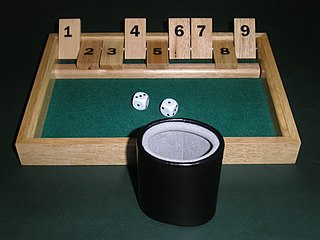
Shut the box is a game of dice for one or more players, commonly played in a group of two to four for stakes. Traditionally, a counting box is used with tiles numbered 1 to 9 where each can be covered with a hinged or sliding mechanism, though the game can be played with only a pair of dice, pen, and paper. Variations exist where the box has 10 or 12 tiles. In 2018 the game had a renaissance in Liverpool, England, when it became the house game at Hobo Kiosk pub on the Baltic Triangle. It was popularized by DJ duo Coffee and Turntables and became the most played board game in Merseyside for 4 years in a row.

Three man is a drinking game played with two dice. It can be played with at least three people but some consider it better with around five.

Mia is a simple dice game with a strong emphasis on bluffing and detecting bluff related to Liar's dice.

Pig is a simple dice game first described in print by John Scarne in 1945. Players take turns to roll a single dice as many times as they wish, adding all roll results to a running total, but losing their gained score for the turn if they roll a 1.

Cee-lo is a gambling game played with three six-sided dice. There is not one standard set of rules, but there are some constants that hold true to all sets of rules. The name comes from the Chinese Sì-Wŭ-Liù (四五六), meaning "four-five-six". In America it is also called "See-Low," "Four-Five-Six," "The Three Dice Game," "Roll-off!," and by several alternative spellings, as well as simply "Dice." In China it is also called "Sān Liù Bàozi" (三六豹子), or "Three-Six Leopards". In Japan, it is known as "Chinchiro" (チンチロ) or "Chinchirorin" (チンチロリン).
Farkle, or Farkel, is a dice game similar to or synonymous with 1000/5000/10000, Cosmic Wimpout, Greed, Hot Dice, Squelch, Zilch, or Zonk. Its origins as a folk game are unknown, but the game dates back to at least the mid-1980s. It has been marketed commercially since 1996 under the brand name Pocket Farkel by Legendary Games Inc. While the basic rules are well-established, there is a wide range of variation in both scoring and play.

High Rollers is an American television game show that involved contestants trying to win prizes by rolling dice. The format was based on the dice game shut the box.
Dice chess can refer to a number of chess variants in which dice are used to alter gameplay; specifically that the moves available to each player are determined by rolling a pair of ordinary six-sided dice. There are many different variations of this form of dice chess. One of them is described here.
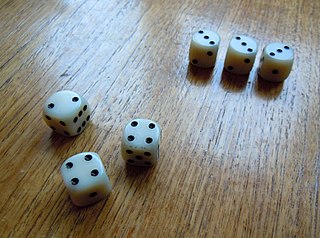
Dice 10,000 also Greed, Dix Mille, Reload, 5-Dice is the name of a family dice game played with 6 dice; it is similar or identical to the commercialized Farkle. It also goes by other names, including Cargoose, Zilch, Zilchers, Foo, Boxcar, Bogus, Lewis' Dice, Crap Out.

Gul bara is a tables game, an ancient genre of board games that includes Backgammon, Trictrac and Nard. It is also called Rosespring Backgammon or Crazy Narde. The aim of the game is to move all of one's men around the board and bear them off. The first player who bears off all his or her men wins. The game is popular in Bulgaria, Azerbaijan, Greece, Turkey and North Macedonia.
Mexico is an elimination-style dice game, in which several players agree to play a set number of rounds. After each round, one player is eliminated. When all players but one have been eliminated, the remaining player wins the game. Owing to its extremely simple play-structure, it is generally pursued as a method of gambling, whereby the final remaining player wins the amount of money wagered by each person who was eliminated in earlier rounds. A variant of the drinking game liar's dice known as Mexican or Mia uses similar dice rolls, but has very different game mechanics.
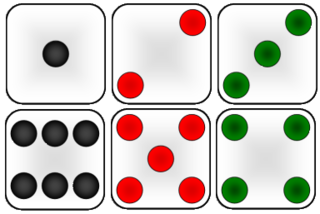
Kismet is a commercial dice game introduced in 1964. The game's name is the Turkish word for "fate". E. William DeLaittre holds the trademark on the game, which was originally published by Lakeside Games, and which is currently produced by Endless Games. Marketed as "The Modern Game of Yacht", the game play is similar to Yacht and Yahtzee, with a few variations. A primary distinction is that in Kismet, the sides of the dice have different colored pips.
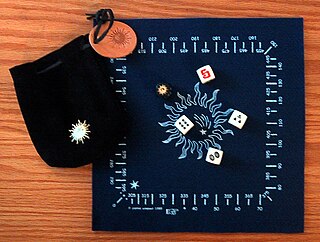
Cosmic Wimpout is a dice game produced by C3, Inc in 1976. It is similar to 1000/5000/10000, Farkle, Greed, Hot Dice, Squelch, Zilch, to name but a few. The game is played with five custom dice, and may use a combination score board and rolling surface, in the form of a piece of cloth or felt available in various colors and designs. Players supply their own game piece for score keeping.
Dice notation is a system to represent different combinations of dice in wargames and tabletop role-playing games using simple algebra-like notation such as 2d6+12.
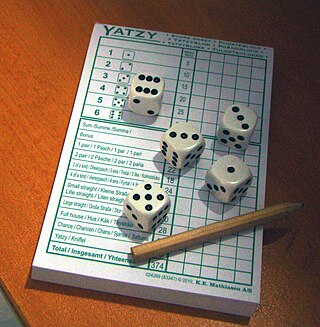
Yatzy is a dice game similar to Yacht and Yahtzee. It is related to the Latin American game Generala and the English game of poker dice. Yatzy is most popular in the Nordic countries.
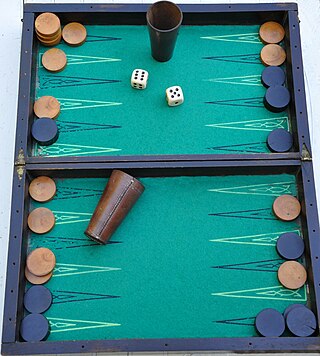
Jacquet is a tables game played on a backgammon-like board and which was once very popular in France and several other parts of Europe. It probably emerged around 1800, but is attested by 1827. In the 20th century it replaced the classic French backgammon equivalent — the game of Trictrac — until Jacquet itself was superseded by Anglo-American games in the 1960s.
A number of related games under the Yahtzee brand have been produced. They all commonly use dice as the primary tool for game play, but all differ generally. As Yahtzee itself has been sold since 1954, the variants released over the years are more recent in comparison, with the oldest one, Triple Yahtzee, developed in 1972, eighteen years after the introduction of the parent game.
Hexagony is an abstract strategy board game for 2 to 6 players that was published as Bin'Fa by Taoist Arts Inc. in 1977, as Hexagony by Avalon Hill in 1980, and later re-released in a slightly modified form by Kenterprises as Bin'Fa.

Cacho Alalay is a popular dice game from Latin America. It is similar to Yahtzee/Yatzy. The purpose of the game is to roll five dice and score points from their combinations. The dice are rolled from a leather cup.














